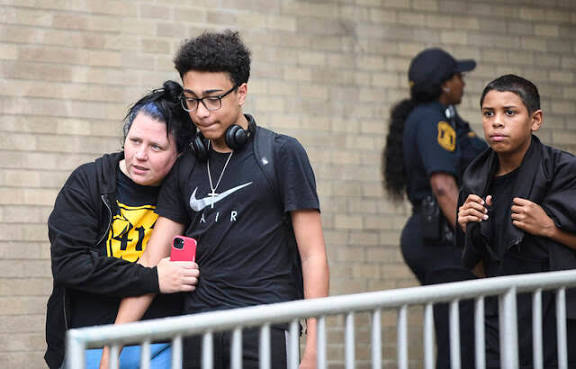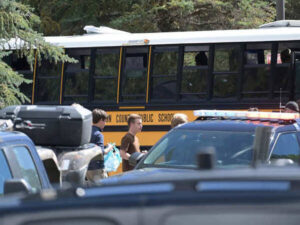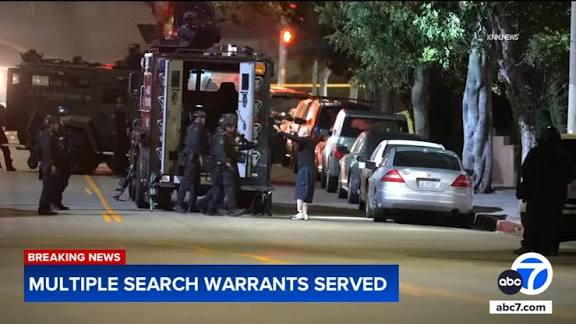3 Students injured Carrick HS Stabbing: School on Lockdown

On Wednesday morning, a student is in critical condition after stabbing three students during a dispute at Caric High School. Today we will discuss about 3 Students Injured in Carrick HS Stabbing: School on Lockdown
3 Students Injured in Carrick HS Stabbing: School on Lockdown
On the morning of September 24, 2025, a terrifying event unfolded at Carrick High School in Pittsburgh: three students were stabbed, sending the school into lockdown and setting off a swift police response. The incident, still under investigation, raises urgent questions about school safety, youth violence, and prevention strategies.
Immediate Incident Overview

According to local authorities:
-
The confrontation occurred around 8:30 a.m., shortly after classes began.
-
The suspect is a 16-year-old male student, who was apprehended and is currently in custody.
-
The victims are male students aged approximately 15 to 18 years.
-
Two of the stabbed students were taken by EMS to hospitals with stab wounds to the abdomen; a third sustained a minor laceration and was treated on site.
-
One of the injured students was reported to be in critical condition, while another was in stable condition.
-
The suspect also had a laceration to his hand, treated by medics before being handed over to police.
-
The school was placed in “secure” status / lockdown, meaning external doors were locked, and the day proceeded with restricted access and controlled release of students.
-
Parents were permitted to sign out their children; school remained in session with those controls in place.
-
The school district is providing counseling support and evaluating whether additional interventions may be needed.
Officials have emphasized that this was not a random attack, but rather stemmed from an altercation in a hallway. Video surveillance and interviews are being used to piece together how the weapon was brought into the building and how the confrontation escalated.
Context & Security Measures at Carrick HS
The unfolding of this event raises questions about the school’s security protocols and how such a weapon could enter campus.
-
Metal detectors: The school reportedly uses metal detectors at the front entrance and downstairs entrances.
-
However, late-arriving students sometimes enter via the cafeteria entrance, which may have more relaxed screening or different bottlenecks. It’s through this route that the suspect is believed to have entered.
-
Officials are examining security video to trace exactly how the weapon bypassed detection.
-
The district’s safety office and police are working together to assess whether existing protocols are adequate or require reinforcement.
School safety is always a balancing act: making the environment secure while trying not to create prisonlike conditions or an atmosphere of fear. But when tragedies like this happen, it draws attention to whether enough preventive steps were in place—and whether more robust systems are needed.
Impact on the School Community
The reverberations of such an incident go far beyond the immediate injuries. The emotional, psychological, and reputational fallout can be profound.
Students & Staff
-
Witnesses and bystanders are likely traumatized. Students may have seen or heard violence close by.
-
Staff and teachers must manage keeping remaining students calm, secure, and focused while emergency responders handle the scene.
-
Counseling and crisis response resources become essential—both immediately and in the weeks that follow.
-
There is a potential for increased anxiety, distrust, or fear within the student body.
Parents & Families
-
Parents rushing to the scene must wait for verification to sign students out—a harrowing experience while waiting for information.
-
Families of the injured face uncertainty, fear, and possibly long recoveries.
-
The community will demand transparent answers: How did this happen? Could it have been prevented? What changes will be made?
School District & Reputation
-
Confidence in the school’s ability to maintain a safe environment is shaken.
-
The district may face scrutiny, criticism, or legal questions if lapses are identified.
-
Other schools may re-evaluate their own policies in the wake of this event.
Analysis: Why School Violence Happens & What Can Be Done
This incident at Carrick High School is, unfortunately, part of a broader pattern of school violence in the U.S. and worldwide. To reduce risks and improve response, several factors and strategies bear consideration.
Root Causes & Risk Factors
-
Conflict escalation: Many school attacks begin with a dispute, perhaps over bullying, relationships, peer pressure, or past grievances.
-
Access to weapons: Knives are relatively easy to obtain, making them common tools in spontaneous violent acts.
-
Warning signs: In many cases, perpetrators exhibit behavioral shifts—withdrawal, aggression, threats, or expressions of hopelessness—before acting.
-
Mental health and support gaps: Students in crisis may not have timely access to counseling or intervention.
-
Ineffective prevention or supervision: Weak oversight in hallways, blind spots, crowded corridors, or unsupervised zones can become hotspots for incidents.
Best Practices & Preventive Strategies
-
Comprehensive threat assessment programs
Many effective districts use multidisciplinary teams (counselors, administrators, law enforcement) that evaluate reported threats or troubled students to intervene before violence. -
Access control and security layering
While no single measure is foolproof, layers (metal detectors, controlled entry points, locked doors, security cameras, and staff presence in corridors) can make it more difficult for weapons to enter or for aggressors to reach targets. -
Staff training in de-escalation and active response
Teachers and staff should be trained to recognize warning signs, intervene in conflicts, and respond during critical incidents. -
Student education and empowerment
Programs teaching nonviolent conflict resolution, peer mediation, and how to report concerns anonymously help build a proactive safety culture. -
Mental health support and counseling access
Ensuring students have counselors, social workers, and mental health resources that they can reach before issues escalate. -
Transparent communication with all stakeholders
After incidents, clear communication with students, parents, and media helps reduce rumors, calm fears, and maintain trust. -
Post-incident review and continuous improvement
After any event, thorough after-action evaluation helps identify gaps and strengthens future prevention.
When schools implement multiple overlapping strategies, they are often more resilient to surprises and better able to prevent or mitigate violence.
Comparisons to Other School Stabbings
While campus violence is never commonplace, similar incidents have occurred elsewhere that underscore both the danger and the lessons learned.
-
In Franklin Regional High School (2014, Pennsylvania), a 16-year-old attacked dozens of students with kitchen knives, severely injuring many before being subdued.
-
In Nantes, France (2025), a teenage attacker wounded multiple students in a stabbing rampage.
-
Globally, schools have struggled with balancing open, welcoming environments and heightened security demands.
Each tragedy offers painful lessons about gaps in awareness, prevention, and response systems—and underscores that vigilance and preparedness are essential no matter a school’s location or demographics.
What’s Next: What the Investigation Must Uncover
The Carrick High School stabbing is now in the hands of investigators. Some of the key questions they need to answer include:
-
How did the knife enter the school? Was there a failure in entry screening or supervision?
-
What was the motive or trigger? Was there prior conflict, threat, or planning?
-
What role did school staff or systems play (or fail to play)? Did any earlier warnings exist?
-
How did students and staff respond? Did emergency protocols work as intended? Were lockdowns timely and effective?
-
What support will be provided to victims and witnesses? This includes immediate medical care, psychological services, and long-term recovery.
Depending on findings, consequences may include disciplinary action, system changes, policy overhauls, or even legal outcomes.
Recommendations for Carrick & Similar Schools
In light of this incident, Carrick High and its district should consider:
-
Comprehensive safety audit: An external, objective review of physical security, supervision patterns, entry processes, camera coverage, blind spots, staffing, and procedures.
-
Strengthened entry protocols: If gaps are found in how late students enter (e.g. via cafeteria), reinforce screening protocols or reconfigure routes.
-
Expanded staff presence: More adult supervision in hallways, especially during high-movement times, can deter violence or spot brewing conflicts.
-
Threat reporting systems: Anonymous tip lines or digital apps where students can report concerns or threats without fear of retaliation.
-
Training expansion: Regular drills, scenario-based training, and coordination with local police and first responders.
-
Increased mental health staffing: Ensuring that students have access to counselors, social workers, or behavioral intervention teams.
-
Open community engagement: Informing parents and community members about policy changes, soliciting feedback, and building trust.
-
Long-term monitoring: Tracking trends in disciplinary data, conflict resolution referrals, behavioral incidents, and safety concerns over months and years.
Broader Implications & Lessons for All Schools
The Carrick incident is not isolated. Every school system must grapple with similar risks. Some broad takeaways:
-
No school is immune. Violence can occur in any community; prevention efforts must be universal rather than reactive.
-
Prevention is better than reaction. Though emergency response is critical, preventing incidents before they escalate must be the priority.
-
Culture matters. Schools where students feel connected, respected, and heard often have fewer behavioral crises.
-
Collaboration is essential. Police, mental health agencies, social services, parents, and local government must all be coordinated.
-
Transparency and trust reduce fear. When communities know what’s happening, how it’s being addressed, and that changes are underway, confidence can be restored.
Conclusion
The stabbing incident at Carrick High School is tragic, alarming, and traumatic—not just for the wounded, but for the entire school community and beyond. It lays bare vulnerabilities in school safety systems and the urgent need for vigilance, compassion, and strategic prevention.
As the investigation proceeds, accountability and reflection must follow. But forward momentum is also essential: strengthening security, expanding student and staff supports, refining early warning systems, and enhancing the culture of care in schools.
How useful was this post?
Click on a star to rate it!
Average rating 0 / 5. Vote count: 0
No votes so far! Be the first to rate this post.
About the Author
usa5911.com
Administrator
Hi, I’m Gurdeep Singh, a professional content writer from India with over 3 years of experience in the field. I specialize in covering U.S. politics, delivering timely and engaging content tailored specifically for an American audience. Along with my dedicated team, we track and report on all the latest political trends, news, and in-depth analysis shaping the United States today. Our goal is to provide clear, factual, and compelling content that keeps readers informed and engaged with the ever-changing political landscape.




